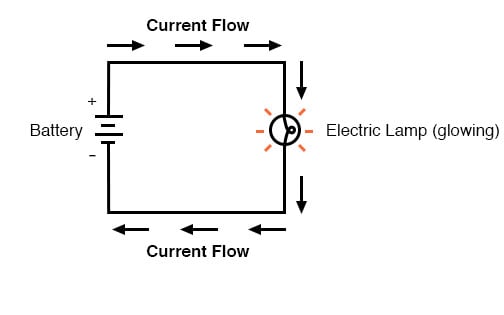What is Ohm’s Law?
Ohm’s law deals with the relationship between current, voltage and ideal resistance. Ohm’s Law is a formula used to calculate the relationship between voltage, current and resistance in an electrical circuit. More formally, Ohm’s law states that the current through a conductor between two points is directly proportional to the voltage across the two points.
Introducing the constant of proportionality, the resistance, one arrives at the usual mathematical equation that describes this relationship as “V=IR”, or “I=V/R”. The basic equation for Ohm’s law is shown below:


This relationship was introduced by German physicist George Simon Ohm. That is why the law is well known as Ohm’s law.

Ohm’s law first appeared in the book written by Georg Simon Ohm (German) in 1827.
Ideal Resistance
Before going to actual topic let us know what is an ideal resistance. Ideal resistance is that resistance which possesses the property of pure resistance and also it doesn’t change its resistivity due to change in voltage or current imposed on it.
Statement of Ohm’s law
At constant temperature, the current through an ideal resistor is directly proportional to the voltage applied across the resistor.
The constant of proportionality is written as R and this is the resistance value of the resistor.
Ohm’s Law Formula

The relationship between current, voltage and resistance can be written in three different ways. When a known voltage is applied across a known resistance the current through the resistance can be determined by the relationship
When a known current flows through a known resistance the voltage appeared across the resistance can be determined by the relationship
When a known voltage is applied across a resistance and the current through the resistance is also known then the value of the reactance can be determined by the relationship:
Determining Power from Ohm’s Law
When current flows through a resistance there will be a dissipation of power from the resistance. This power can easily be determined by using Ohm’s law. As we know power is the product of current and voltage. If the current I ampere flows through a resistance and voltage V volts is the voltage across the resistance then power Using Ohm’s law we can write:
From that relationship we can determine power of a resistance if either voltage and resistance or current and resistance are known to us.
From the same relation for a given dissipated power, we can determine the unknown resistance value of either current or voltage is known.
If any two of power, current, voltage and resistance are known then with the help of Ohm’s law we can find out other two variables.
Why the temperature is kept constant in Ohm’s law
The main criteria for Ohm’s law is to keep the resistance constant because proportionality constant in the relationship is resistance R. But we know that the variation of temperature affects the value of resistance so to keep the resistance constant during experiments of Ohm’s law the temperature is considered constant.
Applications of Ohm’s Law
There are thousands of applications of this law in our daily life. We will show only a few of them in this article.
- Conventional Domestic Fan Regulator is one very common device where the current through the fan gets regulated by controlling the resistance of the regulator circuit.
- In voltage divider circuit this law is used to divide source voltage across the output resistance.
- In electronic circuits, there are many purposes where intentional voltage drop is required to supply specific voltage across different electronic elements. This is done by applying Ohm’s law.
- In mainly dc ammeter and other dc measuring instruments shunt is used to divert current. Here also Ohm’s law is used.
The list will continue as much as you think.
Limitation of Ohm’s Law
The limitations of Ohm’s law are outlined below:
- This law cannot be applied to unilateral networks.
A unilateral network has unilateral elements like diode,transistor etc., which do not have same voltage current relation for both directions of current. - Ohm’s law is also not applicable for non – linear elements.
Non-linear elements are those which do not have current exactly proportional to the applied voltage, that means the reistance value of those elements changes for different values of voltage and current. Examples of non – linear elements are thyristor, electrical arc etc.
Analyzing Simple Circuits with Ohm’s Law
Let’s see how these equations might work to help us analyze simple circuits:

In the above circuit, there is only one source of voltage (the battery, on the left) and only one source of resistance to current (the lamp, on the right). This makes it very easy to apply Ohm’s Law. If we know the values of any two of the three quantities (voltage, current, and resistance) in this circuit, we can use Ohm’s Law to determine the third.
In this first example, we will calculate the amount of current (I) in a circuit, given values of voltage (E) and resistance (R):SCROLL TO CONTINUE WITH CONTENT

What is the amount of current (I) in this circuit?

In this second example, we will calculate the amount of resistance (R) in a circuit, given values of voltage (E) and current (I):

What is the amount of resistance (R) offered by the lamp?

In the last example, we will calculate the amount of voltage supplied by a battery, given values of current (I) and resistance (R):

What is the amount of voltage provided by the battery?

Ohm’s Law Triangle Technique
Ohm’s Law is a very simple and useful tool for analyzing electric circuits. It is used so often in the study of electricity and electronics that it needs to be committed to memory by the serious student. For those who are not yet comfortable with algebra, there’s a trick to remembering how to solve for anyone quantity, given the other two. First, arrange the letters E, I, and R in a triangle like this:

If you know E and I, and wish to determine R, just eliminate R from the picture and see what’s left:

If you know E and R, and wish to determine I, eliminate I and see what’s left:

Lastly, if you know I and R, and wish to determine E, eliminate E and see what’s left:

Eventually, you’ll have to be familiar with algebra to seriously study electricity and electronics, but this tip can make your first calculations a little easier to remember. If you are comfortable with algebra, all you need to do is commit E=IR to memory and derive the other two formulae from that when you need them!
REVIEW:
- Voltage is measured in volts, symbolized by the letters “E” or “V”.
- Current is measured in amps, symbolized by the letter “I”.
- Resistance is measured in ohms, symbolized by the letter “R”.
- Ohm’s Law: E = IR ; I = E/R ; R = E/I









3 thoughts on “Ohm’s Law”
Comments are closed.